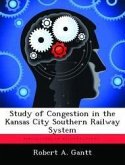Rail yards serve as major nodes that facilitate delivery of cargo to the consignee. The level of operational efficiency maintained within rail yards determines whether customers receive cargo late. Various external and internal factors can impede the operational efficiency of rail yards. The future growth of rail industry depends on how well it manages a potentially serious problem inherent to all railroads--rail congestion. This study reviews the processes that occur within the Knoche rail yard, which is located in Kansas City, Kansas, and also examines several strategies to improve the operational efficiency of the yard's rip track facility. This study reveals that the operational efficiency of the Knoche rail yard may be enhanced if the following occur: (1) increase the rip track facility queue population from fifteen to twenty-two, and (2) spot bad order cars directly onto the two tracks leading into the rip track facility. Finally, the amount of double handling by switch engines daily may be decreased by as much as 96% within the rail yard.








